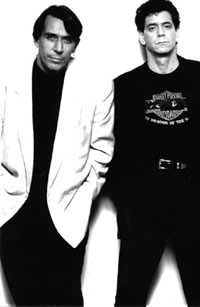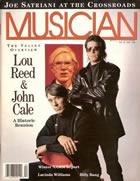

Interviews
Bloodied but Unbowed
Interview by Scott Isler. Published in Musician no. 126 - April 1989
Violence, Viola and Enigma Variations

JANUARY 1988: Cale arrives promptly at a Greenwich Village coffee shop, looking professorial in a dark herringbone tweed jacket over a sweater over a blue shirt. In his late 40s, he cuts an imposing figure: largish build, but with the tucked-in look someone who works out. A shock of hair falls over his forehead, accenting his broad features. The voice retains a Welsh accent, with rolled Rs and muzzy intonation. A week earlier Cale played with band at New York's Bottom Line. He looked distinguished in a pin-striped ruffled shirt with Eton collar and suspenders, while grinning maniacally through 'Guts" or screaming cathartically on "Leaving It All Up to You." Cale screams well. At the end of the set he bowed formally to the cheering audience.
Two months later Cale would be playing piano at the American premiere of his 1987 Falklands Suite, four Dylan Thomas poems and three interludes all scored for chamber orchestra, pedal steel guitar and children's choir. No rock 'n' roll animal here.
It sounds like culture shock, but Cale has always moved gingerly between these two musical worlds. Indeed, his resume and conversation suggest that rock, not "classical," is more foreign to his taste. "Instead of putting bands together when I was a kid," he says, "I used to play viola concertos with youth orchestras." He left his native South Wales to study classical music at London University in the early '60s. From there he went to the Eastman Conservatory at Tanglewood on a Leonard Bernstein scholarship. By 1964 Cale was in New York, working with proto-minimalist composer La Monte Young and discovering pop music.
A fortuitous business encounter threw Cale and Lou Reed together in a touring band to promote a pseudo-dance craze number Reed had written called "The Ostrich." "That was a song," Cale remembers, "written entirely by detuning the six strings of a guitar down to a B – six B strings. You played the whole thing by barring it."